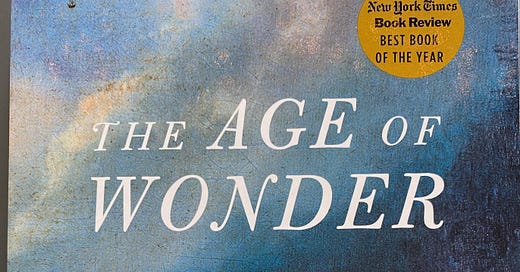Book Review: The Age of Wonder by Richard Holmes
The Age of Wonder (2008, Vintage Books) focuses on some of the engaging figures in science as it emerges from its chrysalis into the modern discipline – the title reflects the blending of data and observation with musing on the sublime, the supernatural, and the holy that characterized the era. It roughly covers the years 1768 to 1820; the dates are my own, beginning with Cook’s voyage to Tahiti, New Zealand, and Australia to the year of Joseph Banks’s death.
Holmes is a scholar of the Romantic era, and his long list of books focuses on poets: Shelley and Coleridge in particular; this book covers the same era but focuses on different figures. Holmes first introduces us to the young Joseph Banks in Tahiti. After that epoch-making voyage, Banks became a powerful and influential patron of science. Using Banks as a through line, Holmes then introduces us to some interesting figures of the era, all correspondents or proteges of Joseph Banks. The selection of topics seems to be more influenced by a good story rather than work that lasted, which I offer as an observation rather than a critique. Good stories are worth telling. However, this is not a book about the era's five or six most important figures in science.
We meet the endearing brother-and-sister team of William and Caroline Herschel, both astronomers. Then Humphrey Davy, a chemist and a Romantic in the sense of the movement, is discussed. Davy’s life story helps illuminate both the intertwining of the Romantic and the scientific and social changes of the time. Mungo Park stands in for a range of explorers of Africa, most of whom, including Park, died in Africa, sacrificing their lives for discovery, information, and glory. Holmes reviews the work of early balloonists who are somehow less memorable, possibly because there are several of them, or because ballooning didn’t take off. Finally, Holmes introduces Mary Shelley and her groundbreaking work of science fiction: Frankenstein or A Modern Prometheus. Including an author in this book full of scientists helps develop the idea that the era was asking big questions about life and the soul while identifying elements, naming comets, and designing safety lamps.
The book’s language is easy to read and comfortable without being overly simple. Illustrations are plentiful and to the point, and Holmes includes a “cast of characters,” helpful in a book this full of interesting people, as well as references and an index. The Age of Wonder was named a NYT Book Review “Best Book of the Year” in 2009 and is widely available for sale and in public libraries.




